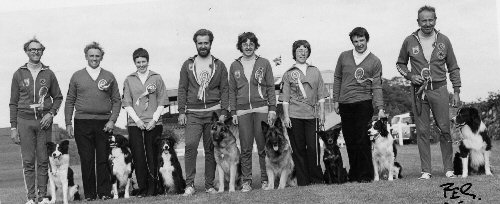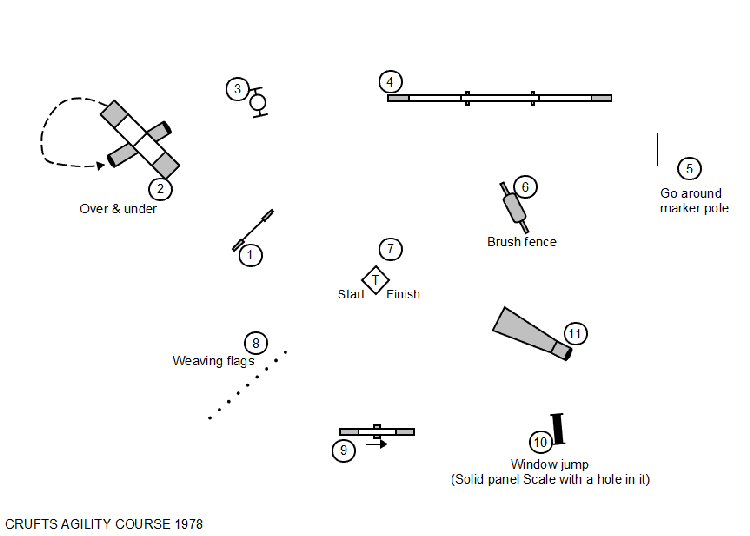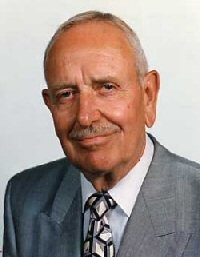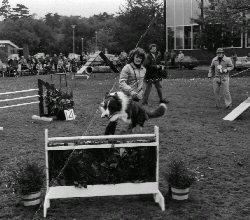Behind the scenes at the first Agility
demonstration...
 Did
you know that the person placed in charge of running Crufts 1978 Main Ring
events knew nothing about dog training? Instead, he had horse background. He,
therefore, asked senior Kennel Club staff if there was someone who could put
together a 'dog jumping event' similar to Show Jumping for horses and was pointed
in the direction of Peter Meanwell. And that's how Peter Meanwell became one of
Agility's founding fathers, and rightly so. Peter Lewis was
there to see it all. Did
you know that the person placed in charge of running Crufts 1978 Main Ring
events knew nothing about dog training? Instead, he had horse background. He,
therefore, asked senior Kennel Club staff if there was someone who could put
together a 'dog jumping event' similar to Show Jumping for horses and was pointed
in the direction of Peter Meanwell. And that's how Peter Meanwell became one of
Agility's founding fathers, and rightly so. Peter Lewis was
there to see it all.
Peter
Meanwell was an experienced and popular dog trainer at Lincoln GSD & All Breeds
Training Society in the 1970s. At the time, he was handling Border Collies
named Laddie and Jamie in Working Trials which is how we met and how he became a
great friend of mine.
For many
years, the national police and military dog establishments, in particular the
RAF, had been using various pieces of equipment for training and display
purposes. During the research for a book I wrote about Working Trials in the
70s, I was told about the 'Send Great Danes' and the jumping competitions that
were held with them in the 1930s. So it seems that dog jumping, on an informal
and low key scale, had been around for very many years. It was not new.
 Planning Planning
As
my old friend Peter put it, he gathered around him a group of friends from
Lincoln GSD & All Breeds Training Society, as well as several from Yorkshire Working
Trial Society to plan the this new dog jumping event and decide on the equipment to be used. There
was at least one police dog handler at the Club who was able to put him in touch
with other officers with similar animal skills.
They agreed
upon using many the pieces of apparatus already employed at military and police
demonstrations, placed in a figure of eight pattern with the table playing a
prominent part. It was the starting point, cross over obstacle for a 'down five
second wait' and the finish on the table. The judge, Fred Welham, was static
near to the table with a Secretary, while the Flag Stewards were placed at the
ring corner, with which the down side contacts were also pointed to. Handlers
negotiated the course with their dogs beside them in the traditional left side
heel position at a gentle trot.
The
first agility exhibition at Crufts
Basically
it was a demonstration run as a competition with two teams of four dogs each -
one from Lincoln and the other from Yorkshire DTS. At this fledgling stage of
agility, the course pattern never varied, nor did the equipment. There were
all sorts of different ways dogs could be faulted with differing numbers of
faults, and the contact points were one of them. There was also a window jump
with a 4ft landing for the dog.
The crowd
loved this opening act for the Best in Show evening. Those who
had already judged training events, however, foresaw what the problems could be. One
such was a 'static'
judge who had no chance of observing the down side of the contacts. Stewards had to make the decisions. Another problem was the accuracy of the manual 5 second down count in
the middle of the ring to say nothing of the fact that the judge had to take his eyes
off the dog to talk to the Secretary.
In actual
fact, it was a kind of organised chaos, with friends of handlers claiming the
Steward had wrongly faulted their dog on a contact. However, only those
involved or 'in the know' noticed. As a spectacle, it was a great success, and
anyway, the result was supposed to be superfluous to the entertainment. You know
the old British thing of 'It's not who wins but taking part.'

When asked for my
opinion after the first demonstration I have to admit that I was economical with
what I said.
After
that...
It
was not until my old friend Peter Meanwell put on his demonstrations at Crufts
`78, `79 and `80 that we rea;ised that this way of dogs negotiating equipment as a viable dog
sport in it's own right. What was so clever about the demonstrations was that
the concept. The equipment that was used was always visible and very easy to replicate so it
easy to do such demonstrations elsewhere.
Some
friction developed within the Lincoln Club, probably over who was to be in their
team at Crufts. Peter abhorred anything like that for, by nature, he was a
peacemaker, a person whom I never found to be at all belligerent. That explained
why he never referred to his team as being 'part of his club,' but rather as
friends of his from that club. Nevertheless, the fact remains that they were
Lincoln GSD & ABTS members, despite friction occurring. There
were three years of these Crufts demonstrations with the last one being in 1981
when he asked me to be with him in the ring as his Secretary, thus avoiding him
having to choose a person from his club.
 Always
discreet, he kept these problems quiet and, in the end, just walked away from them,
completely fed up with all the argy bargy. After all, his great love was
Working Trials. It looked as though that was the end of dog jumping, but Crufts
had stirred people’s interest. Always
discreet, he kept these problems quiet and, in the end, just walked away from them,
completely fed up with all the argy bargy. After all, his great love was
Working Trials. It looked as though that was the end of dog jumping, but Crufts
had stirred people’s interest.
Agility
is recognised
One or two people started to put on competitions of their own, based upon
the first Crufts demonstrations. This made some people ask why 'illegal' dog
jumping competitions were being held. It was a complaint that came before the
Kennel Club’s Working Trial Council which I was privileged to be chairing at the
time.
We passed it to higher Kennel Club committees,
and they instructed that
a set of rules and regulations should be made. Probably because of my involvement with the Working Trials
Council, I became part of the Dog Jumping Rule Making Committee. It
seemed I was expected to be one of the members as I was the one who put the problem before
them in the first place. I was not too happy about this for I was being asked
to make rules for something I actually disliked!
Some weeks
later, I was on the train on the way to attend the first Dog Jumping Rules Sub-committee
meeting, berating myself for accepting my nomination. On that journey, I
started to ask myself some soul searching questions. What could I really say
was wrong with dog jumping? I eventually had to concede that I couldn't find
one sensible reason. Therefore, I asked myself why I was against it? I
immediately realised that I didn't have a single valid reason so I decided to be for
it rather than against it. I then went even further deciding to back it wholeheartedly. That's my nature. I never do anything by halves. In anything I
had taken part in
during my life, I have always contributed to the best of my ability.
Peter
Meanwell was invited to be a rule making member too, but had to decline as he was to be
away on business in the USA.
We decided to call
this new activity Agility Tests as we
suspected that 'dog jumping' would not be an acceptable title for those with more say
in the matter. The Sub-committee sat twice in 1979 and, in effect, those two
meetings were indeed my first official involvement with the sport. As I now
look back, I realise there was not one person on the Committee who had been part of those
first Crufts demonstrations in `78 and `79. In retrospect, that was a probably a
good thing for there were no entrenched positions to overcome.
We
discarded the window jump as too high a landing for the dogs, and also because it would
have been an extra sight barrier for the judge. We made the game-changing rule that every course would be
new, designed by the judge and kept a
secret until built on the day. That really put the skill and variation factor
into what was to be our sport.
What a
difference on my journey home! My mind was working overtime. How could
I build a set of equipment to train Spot, my Ticket class Obedience dog, to
become an Agility dog. I did all that, so at Christmas in 1980, Spot and I
competed in the last eight of the Olympia finals when I started a lasting
friendship with Dave and Mary Ray.
 The rest
is history... The rest
is history...
1980 saw the first official Agility competition
at Crufts and with it came a new atmosphere to the event.
From then
on, the few of us involved in the early agility built upon what we had and refined other parts. One
major change was to do away with the Secretary in the ring. That meant
we could use hand signals similar to those used for years by cricket umpires. I realised
ours could be much simpler with the open hand held high for non-refusal faults and the fist closed for refusal faults.
At first we used a whistle
for an Elimination.. Then, as extra rings were added, that was changed to a hand signal, the most
amusing being a sign that the handler had cut his own throat but usually it was crossed
hands. Scribe pads needed inventing as did score sheets as they requiring
tailoring to our new game.
In the
first few years, quite a few novelty classes such as Snooker and Gamblers were added.
In the
beginning, there
was no class progression system. That did not become important until
the number of competitors warranted it. In fact, that occurred quite
quickly, and soon we were asking the powers in charge for a class
progression system. At first we seemed to get nowhere. Upon asking a senior member
of the KC staff, we were bluntly told there will never be a Agility Liaison Council
nor Agility
Champions. Who was it said, 'Never say never!' We battled on until, at
last, the person at the pinnacle of dog training decisions - other than Field
Trials - was metaphorically offered the pistol on a silver salver and decided to
resign from his position.
Having
spent many years competing in Obedience and Working Trials, working
out how best to train for this fascinating new game was not difficult for me. I was lucky enough to
quickly become a successful competitor, but then as a Working
Trials enthusiast, I had a head start. I already had some of the basic knowledge
needed or Agility. Remember that the
first demonstrators at Crufts all came from that same long standing discipline.
 I realised
that Agility would need to be fast and not restricted to those figure of eight
demonstrations. Having a newly designed course for every competition
really put the emphasis on skilled dog training. In effect, it made the whole
thing work, freeing it from the inevitable boredom that would have resulted. I realised
that Agility would need to be fast and not restricted to those figure of eight
demonstrations. Having a newly designed course for every competition
really put the emphasis on skilled dog training. In effect, it made the whole
thing work, freeing it from the inevitable boredom that would have resulted.
I am glad
we did not accept the Sub-committee Chairman's desire to stop
the time being taken into consideration for the result. Can you imagine all the
run offs we would have required! We asked why he wanted to do
that, and were told those with less speed should have an equal chance. I
thought about how the Olympic 200 hundred hurdles final would be with rules like
that. He had to give way because we were not going any further if he
insisted.
There are
times in a fledgling sport when a judge creates precedents by making a rule of
their own. For instance, I qualified for the 1980 Olympia Semi-finals with
my Border Collie Spot. Everyone who had judged so far that year was a
competitor in those Semi-finals, so a Working Trials judge who knew nothing
about agility was provided. Bear in mind the new rules were now in place, so
the judge positioned himself just beyond the first two hurdles which commenced
the course.
I was
drawn to run first. As both hurdles were straight on from each other, I gave my ex-obedience dog the command to
'wait' at the starting point and moved up to a strategic position beyond the second hurdle but in line with my dog
and the hurdles. To do that I had to pass the judge whom I knew well from
Working Trials, and he said 'Where do you think you are going?'
I explained
what I was doing, and he said in a loud voice, 'You cannot advance beyond your
dog.' Having been on the KC rule making body, I knew there was no such rule. So while my dog obediently sat at the start, we had what could be politely be
described as a 'discussion.' Luckily, the next competitor heard this interruption
and backed me up, so the 'know nothing' judge backed down. We went clear and
qualified for Olympia 1980. Just think if he had prevailed and that had become
a rule, we might have been stuck with it forever more. We probably would have been stopped from changing handling sides as
well. From there on, I would advise anyone new to the sport to forget all their
preconceived ideas used in other dog training disciplines. In this new one, it
was total freedom for dog and hander to move where they wished. However, the
dog had to complete the course set by the judge in the shortest possible time
and if, course penalties were non-existent or equal, time would prevail.
I've had opportunities to teach Agility in many countries
around the world,
and this basic British concept was always the philosophy I taught. Never was that
more important than when I had to teach the first ten
chosen to be official French KC judges. I already knew enough to understand that
if the French adopted it, then the FCI would.
Oh yes, we
got our International competition with the French, and the FCI played a leading
part in the standardisation of international agility. You could call those of us
who pioneered agility
in 1980 'We happy few.' You could have counted us on two people's hands and toes. Our winners and losers continued
to refine the sport, as did others who flooded into the sport. The speed of the
dogs accelerated quickly and kept increasing as more and more
people joined the sport and developed better training methods.
I suppose
we were lucky for subsequent eras, the world gradually seemed
to reject 'slower' sports with speed and action always seeming to be more popular.
Thank you to Peter Meanwell. Your first demonstrations were not quick in their
execution, but you gave the world the vehicle to change all that with what came
to called Agility, the dog game devised for a handful of people that that became
a sport and has swept the world.
 About
the author... About
the author...
Peter Lewis was one
of those he described as 'we happy few.' His background was that he had
previously competed and judged at the highest level in Obedience and Working
Trials, then went on to do the same with Agility. He taught all three
disciplines around the world and particularly how countries could set up their
own Agility programme. This culminated in the sport being able to be played
internationally without clash of countries differing rules.
Peter spent 20 years as a dog behaviourist,
started competitive Heelwork to Music with Mary and Dave Ray and has been
writing about many of these subjects for some years now. Currently he
writes novels, as computer work makes few demands on his old body.
First publisher 20 May 2016
Peter Lewis©
|